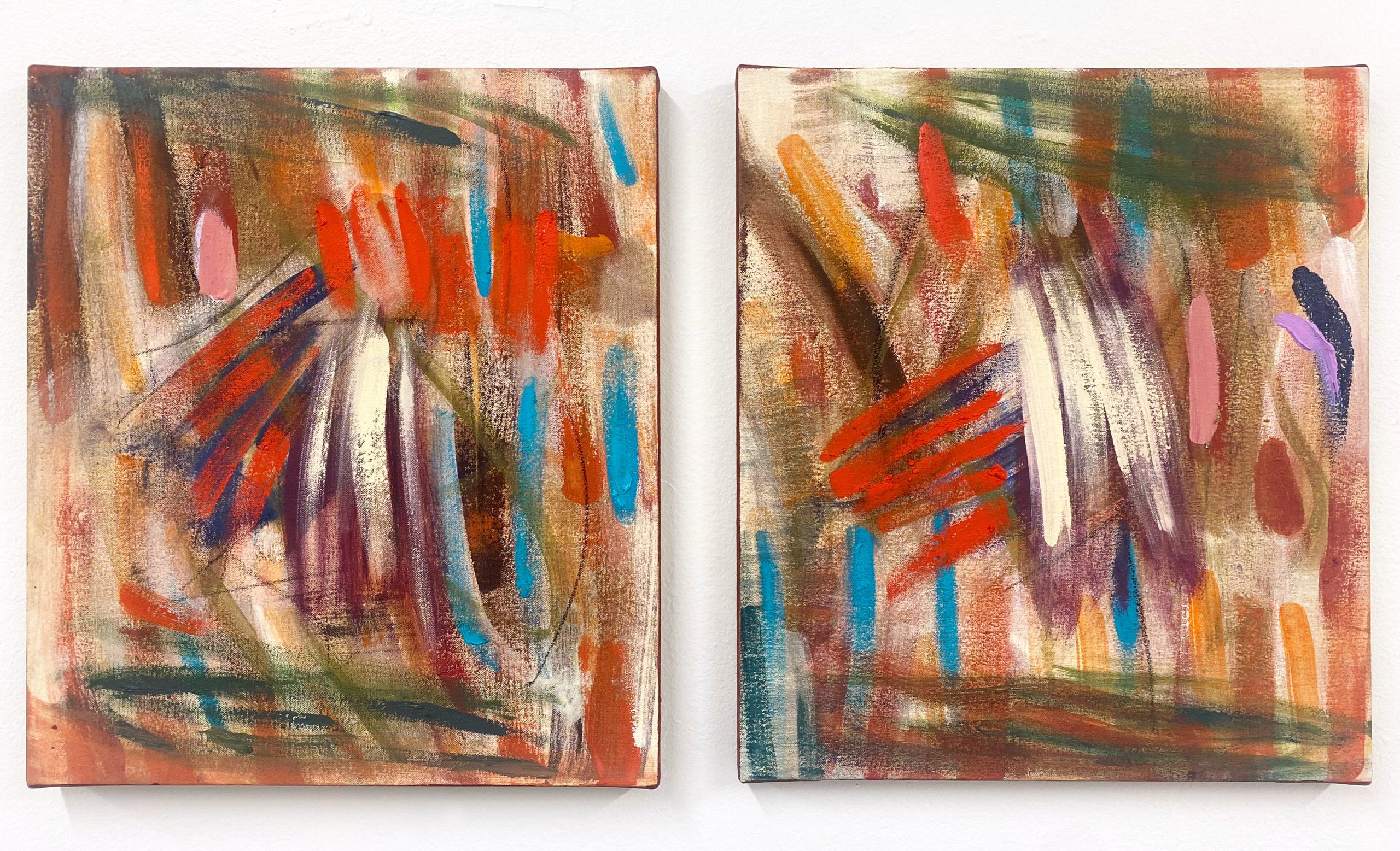
To read this article in Portuguese, click here.
At least since Wassily Kandinsky wrote “Concerning the Spiritual in Art” in 1910, abstract painting and spirituality have been linked. While one narrative of modernist painting argues that abstraction was a way of emphasizing the materiality of the artwork, this narrative has always been shadowed by a spiritual perspective that looks to a higher plane of meaning beyond mere materiality. The recent popularity of Hilma af Klint—a Swedish mystic who described her paintings as communications from the spirit world—indicates the desire to recover this spiritual tradition of abstract painting. The contemporary Brazilian artist Diana Motta is an inheritor of this tradition. Trained in astrology and the philosophy of kabbalah, Motta sees abstract painting as a practice that allows mystic knowledge to find expression through the body. We met to discuss her practice as well as her Brazilian roots, the general interest in spiritual matters today, and her experience in Chicago.
This interview was conducted on May 6, 2024. It has been edited for length and clarity.
Thomas Love: You have three occupations at the same time: professional astrologer, spiritual scholar, and artist. Can you talk about how you came to these different practices and how they inform one another?
Diana Motta: Both my artistic practice and my spiritual practices are about understanding what limits myself and how to break free from those limits and allow magic and revelation to come in. When I was a kid, I could be by myself for hours and hours just drawing and creating. But my family didn’t allow me to go to art school. That’s when my repression began, you know? That’s why I looked for spirituality. I said, “I’m going to have to fight for what my soul wants, which is to be an artist.” Then, when I started as a painter, I worked figuratively, hyper-realistically, and at a very small scale. It was very controlled, very detail-oriented, and everything had to be perfect. The paintings were not about the process but about the result, because I knew exactly how the painting was going to look. My spiritual practice showed me that this came from a lack of trust. I needed to trust my painting in order to be intuitive. I needed to break away from logic, from the rational mind. When I start a painting today, I have no idea how it’s going to come out. Part of the process is trusting something that is higher than me. It’s trusting the unknown. And so the painting reveals itself to me. It’s similar to Hilma af Klint, you know, who said that angels told her what to paint. I feel the same way in the process of my paintings.
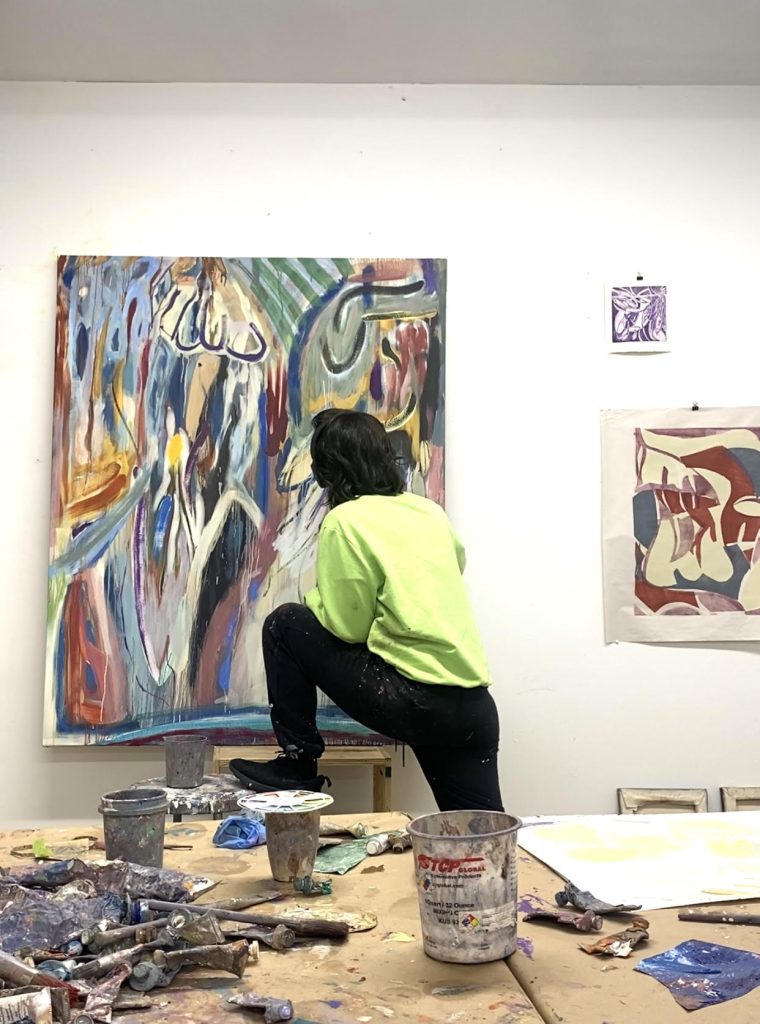
TL: Your style is very different, though. Hilma af Klint’s paintings are abstract like yours, but they are geometric abstraction. They’re almost diagrammatical. Whereas you do gestural abstraction.
DM: Yeah, that’s a good observation. The process is very different, even though we both have the sense of channeling something. I think her body of work is interesting because of her mind-blowing life story. I really respect her as a pioneering woman in abstract art, and I appreciate the color palette, scale, and compositional sensibilities of her work. However, I am not particularly drawn to her didacticism, because that’s not what I feel is exciting about painting at the moment. I see her work as diagramming spiritual worlds. I’m more interested in gesture and body and movement and speed and touch.
TL: Can you talk a little more about how you approach the body? Do you think about your work in terms of gender and sexuality?
DM: I approach gender through symbols and cultural codes. Of course, it’s based on the fact that I was born as a woman, and I see myself and understand myself as a woman. In our culture, being a woman is connected with guilt and shame, desire and temptation. I challenge these ideas through the way I paint, through the relationship between my body and the canvas. There’s a lot of libido involved, although I don’t usually say that explicitly. There’s a lot of flesh in my work and a sense of seduction. The idea is that the relationship between body and soul is like a battle. Similarly, the process of painting is a battle between having control and losing control.
TL: As a queer scholar who works on the politics of representation, I’m interested in how your approach to abstraction makes space for different life experiences. In modernism, abstraction was often meant to have a kind of universality. That was one of the utopian aspirations of abstraction, that it could speak to everyone through a universal formal language. Those aspirations have been criticized for failing to attend to the differences between people, differences of identity—of race or class or gender, for example. But I think spiritualism has a different kind of universality. It offers a system that gives meaning to people’s lives without treating everybody the same. It offers a mystical meaning that can never be fully unveiled. How do you think the spirituality that informs your practice speaks to different viewers?
DM: It’s hard for me to understand how other people see my paintings, because I only have access to my own point of view. But the process is there. My painting is all about layers, so you can see how they were constructed. It’s very interesting because I read an astrological chart almost the same way that I paint. I see past lives in the charts of my clients, and I see how those past lives appear in the present. Similarly, there is a lot of back and forth with time in my artistic work. Because of the layering, you can see how things were built.
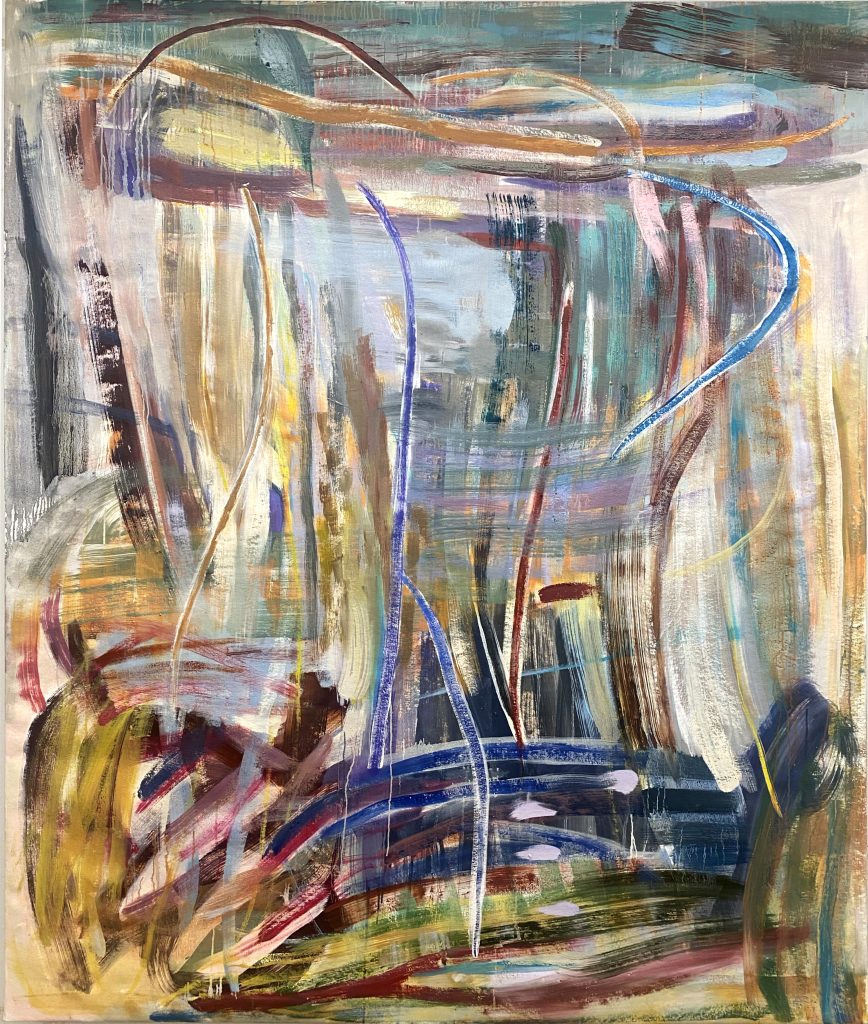
This also connects to my studies of Kabbalah. Kabbalah is a spiritual technology that explains to us how and why the physical universe was created. It’s a rule book for understanding how to make decisions in life based around an understanding of the structure of creation. It’s about having control but at the same time allowing the magic to come in. It’s not supposed to be like “I know everything that is going to happen.” No, it’s supposed to be surprising and awesome. And that’s the process I want my paintings to go through.
TL: When I was looking at your work, I didn’t necessarily think that I had access to your experience of painting. If there was spiritual or symbolic content, that wasn’t something that I felt I could perceive. But I found them very beautiful, very formally interesting, and there is meaning in that. Although your paintings seemed very raw in their mark-making, this rawness was counterbalanced by very precise color choices. But your more recent work is going in a new direction by re-introducing symbolism. So you had this first reaction against hyper-realism that brought you to a kind of raw directness… are you now moving beyond that to something else?
DM: Yes. I’m trying to find the balance. I believe that the paintings talk to me, and they want me to tell a story. For example, I have a painting called Inanna’s Descent, which is based on an ancient Mesopotamian myth about the goddess Inanna, who goes to hell and is born again. It’s actually the description of the synodic cycle of Venus around the sun. Because at one point Venus goes closer to the sun, it kind of burns, dies, and then comes back again. The painting is very sensual in a way, and I felt it was about Venus because Venus represents desire, love, seduction, and pleasure. And so I’m starting to see how abstraction can tell a story.
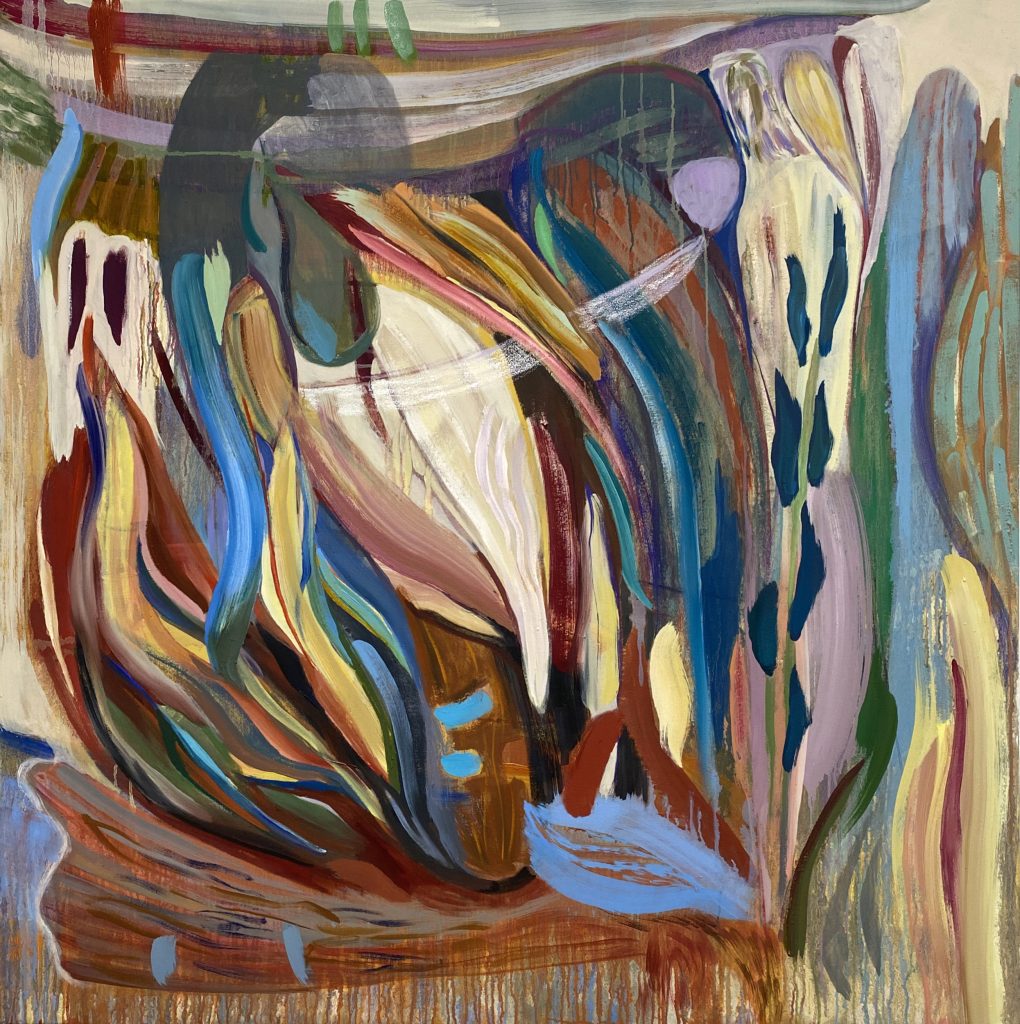
TL: Can you talk about how these stories are rooted in different cultural traditions?
DM: Brazilians incorporate a lot of different traditions because our culture is mixed: we got a little bit from Africa, we got a bit from Italy, Portugal, and the indigenous people, of course. In Brazil, most people are Catholic. But there is also Umbanda and Candomblé, which come from West Africa. I incorporate into my practice the things that speak to my soul and make sense to me.
TL: I think it’s very important to be open to other traditions and to let them speak to you. At the same time, one could say that the whole reason why there’s syncretic religion in South America is because of colonialism and slavery. The movement of peoples is also a history of violence.
DM: You know, I don’t like religion. I’m not saying that religious people are bad people, of course. That’s not a good parameter to judge someone’s character. But there are really negative aspects of organized religion. One of them is the idea that, you know, “my God is better than yours, and I am allowed to treat you badly or even”—God forbid—”kill you because we don’t have the same religion.” This is completely the opposite of what I think. And the idea that “I do this because it’s written in the book. I do this because someone is telling me that I have to do it.” And the third thing is the idea of guilt and shame that comes from religion. I’m totally against the shame and guilt that comes from a person expressing their sexuality or gender how they want. I don’t even understand that.
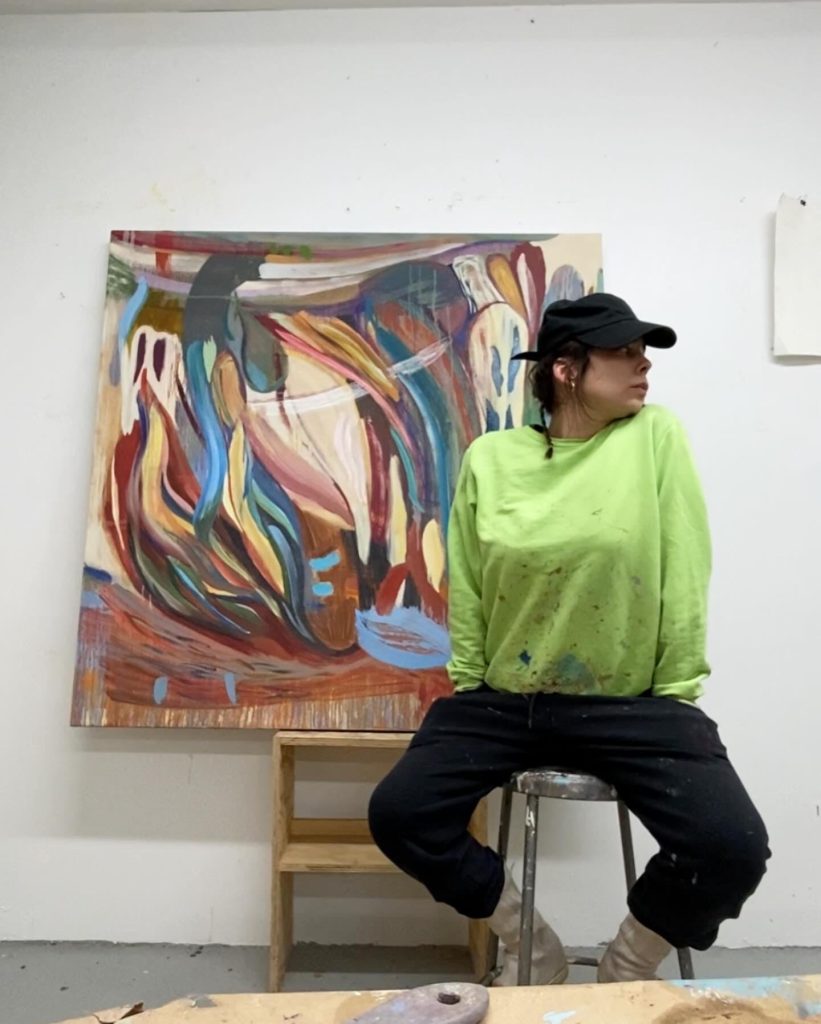
TL: Do you think there is an increased openness to spirituality in contemporary art?
DM: Spirituality is coming up in art a lot. And I question that, because when I wanted to study spirituality, I was slammed by absolutely everybody. My friends, my family, and society. It was a very difficult journey to get where I am now. I have a Portuguese social media account with 24k followers. I am a spiritual influencer. Now I see that everybody is talking about tarot, everybody is talking about astrology and witchy things. Of course I think I’m part of this movement. But where were these people ten or fifteen years ago? Why are they really into spiritualism? I question it because I know how hard it is. Even after sixteen years, I still feel like a beginner in astrology, to be honest, because it has such a long history and there’s so much knowledge.
TL: Do you think Brazilians are more open to spiritual matters than people in the United States?
DM: I thought Americans wouldn’t be interested in astrology. But they are. Not more than Brazilians, but I am surprised by the amount of people I encounter here that are curious about astrology.
TL: Has anything struck you about Chicago, in particular, since you’ve moved here?
DM: I came to Chicago to study at SAIC [the School of the Art Institute of Chicago]. I felt that I had a connection to the city because I had been to Chicago once before, and I fell in love with it. I also wanted to come to Chicago because I love Abstract Expressionism and American art, more generally. I love Joan Mitchell, who is from Chicago. Once I began absorbing this American style of painting, I transitioned away from the kind of work I was doing in Brazil. I also think the contemporary art scene is a very strong community here, and there’s a lot of support. There are a lot of artist-run spaces that welcome artists into the scene. And I’m always down for that. The best part of the art world is being in community with other artists. It’s such an honor to be exhibited alongside artists you admire. Last year, I was in a group show in a very important institution in São Paulo called Farol Santander. It was all paintings of roses. And I was shown alongside some of the most important Brazilian artists like Candido Portinari and Beatriz Milhazes. Marina Abramović was also in the show. The invitation was a surprise to me because the curator didn’t know me personally. He saw my work in a show, kept it in mind, and invited me to be in the exhibition. This was the highlight of my career up to now. I felt so honored.
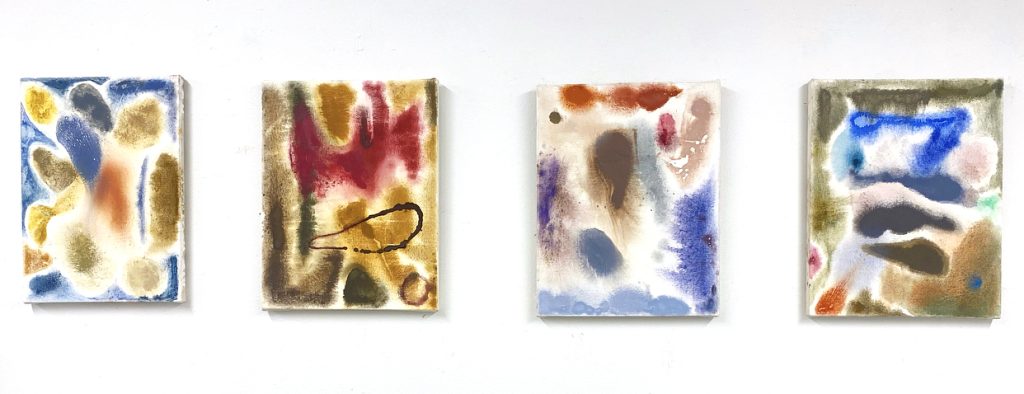
TL: Does your spiritual approach to art ever come into conflict with the economics of the art world? You have this deep connection to the work that you’re making, there may be a magical process of revelation, and then you have to put a price on it and sell it to a collector.
DM: I don’t really care, to be honest. As I said in the beginning, you have to have both the physical world and the spiritual world. I don’t deny the body; I like the body. I like pleasure. Why repudiate money if money allows you to have some pleasure in life?
TL: It certainly helps! So, what’s coming up next for you?
DM: I’m in an all-women group show at Stasias Gallery in Chicago that opens on June 15th. Part of the sales from the show will benefit the charity WINGS, which addresses violence against women, especially domestic violence. We are very pleased to be able to do something to help women in need, to think outside ourselves, and to empower other women. I also have a solo show in July in Shanghai at Ivory’s Gate gallery, a solo show in February 2025 in Taipei at 121 Art Space, and a solo show in Stasias gallery in Chicago planned for January 2025. I hope my practice reaches a broader audience because I see art as a powerful catalyst for change. I want to spread the idea of combining the spiritual and physical worlds together and to bring more people into this miraculous reality.
Diana Motta (b. 1985, São Paulo, Brazil) is currently pursuing her MFA at the School of the Art Institute of Chicago. Motta has exhibited her works in solo exhibitions in Brazil, including at the Zipper Galeria and MuBE Museu Brasileiro de Escultura (both in São Paulo) and Gallery Antônio Sibasolly (Anápolis). She has participated in group exhibitions in Chicago and São Paulo, including at Sulk Gallery, Stasia’s Gallery, and 308 Gallery (all in Chicago); Farol Santander, Galeria de Arte Andre, and Galeria Mamute (all in São Paulo). Motta’s practice references her spiritual journey through the lens of astrology and the Kabbalah school of thought. Originally a figurative painter, Motta shifted her practice towards abstraction as she began questioning the relationship between body and spirit. Transparency and translucency of color in her work reference the thin veil between our physical bodies and the spiritual world. She finds that playing with material and technique creates a juxtaposition between spirituality and sensuality. The body is thus a vehicle to the spiritual. Inspired by Brazilian modernists Tarsila do Amaral and Maria Martins, Motta’s practice finds strong roots in her Brazilian upbringing, where exploration of faith and spirituality is encouraged.
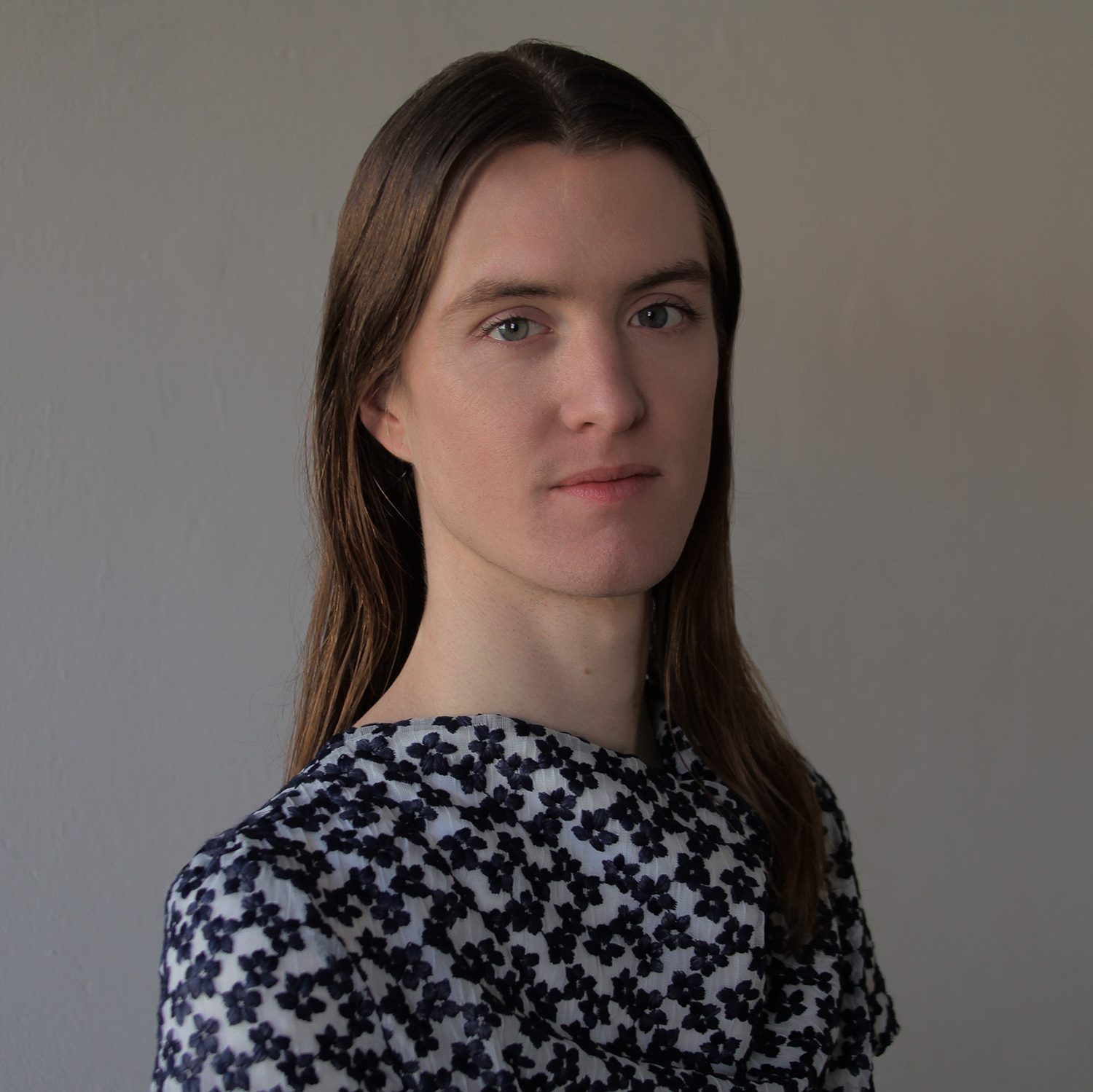
About the author: Thomas Love (b. 1988, Cambridge, MA) is an art historian working at the intersection of contemporary art history, German studies, gender and sexuality studies, and critical race theory. He received his PhD in Art History from Northwestern University in 2023 and is now a Preparing Future Faculty for Inclusive Excellence postdoctoral fellow at the University of Missouri. His current book project, titled Queer Exoticism: Strategies of Self-Othering in West Germany, analyzes queer art in post-’60s West Germany to show how representations of racial and ethnic difference became essential to the formation of contemporary queer identity. His writing has been published in Angela McRobbie (ed.) Ulrike Ottinger: Film, Art and the Ethnographic Imagination (Intellect Books, 2024), as well as in The Germanic Review, Texte zur Kunst, Art in America, and the Art Institute of Chicago’s “Perspectives” series.
